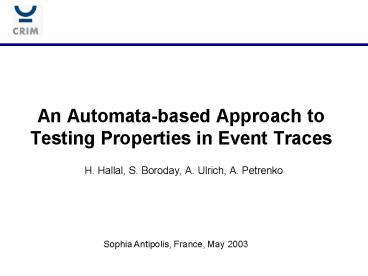An Automatabased Approach to Testing Properties in Event Traces - PowerPoint PPT Presentation
1 / 19
Title:
An Automatabased Approach to Testing Properties in Event Traces
Description:
An Automata-based Approach to Testing ... Lack of global timing. Absence of reference specification ... is transitive: If a b and b c then a c. Event trace ... – PowerPoint PPT presentation
Number of Views:41
Avg rating:3.0/5.0
Title: An Automatabased Approach to Testing Properties in Event Traces
1
An Automata-based Approach to Testing Properties
in Event Traces
- H. Hallal, S. Boroday, A. Ulrich, A. Petrenko
Sophia Antipolis, France, May 2003
2
Outline
- Motivation
- Event traces
- Problem
- Our approach
- Implementation
- Case study
- Conclusions and extensions
3
Motivation
- Analysis of distributed systems is complex and
costly - Asynchrony
- Lack of global timing
- Absence of reference specification
- A practical solution is to instrument the system
to generate traces of events that can be
visualized and analyzed further - This solution can be used to debug the system
- During development
- After deployment
4
Visualization Vs Analysis Tools
- Visualization tools facilitate the manual
inspection of collected traces
- Analysis tools automate the verification of
properties in the traces
Analysis Tools
- elaborate ad-hoc algorithms
- more efficiency
- more efforts
- reuse an existing model checker
- more expressiveness
- less efforts
5
Trace Analysis Problem
- Given
- A distributed system under test (SUT)
- Some properties
- Verify whether the SUT satisfies the properties
- Solution
- Monitor the SUT and collect an execution trace
- Model the collected trace
- Use an existing model checker to verify the
properties
6
Trace
- Distributed processes generate local traces
- Local events state update, parameter change
- Communication events message exchange, RMI, RPC
- Local traces are sequential
- Communication
- Asynchronous send and receive events
- Synchronous rendezvous events
- Point-to-point communication
- Each message has a send and a receive in the
trace - Each rendezvous involves at least two parties
7
Event Traces
- Event ordering induced by local orders ?i and
point-to-point communication - A trace is a partially ordered set E of all
events - Causality relation on events ?
- If a ?i b then a ? b
- for every message m, send(m) ? receive(m)
- ? is transitive If a ? b and b ? c then a ? c
- Event trace
- a tuple of local traces with an irreflexive
causality relation on all events
8
Lattice of Ideals
- Encodes all the possible linearizations of E
- Offers an efficient way to check properties
9
Problem
- Given
- An event trace of a distributed system
- A set of properties
- How to build the lattice of ideals to verify
the properties? - Monolithic approach
- build the lattice explicitly
- use a model checker
- Modular approach
- model the event trace as a system of
communicating automata - build the composition of automata
- prove it is isomorphic to the lattice
10
Our Approach
- We use finite automata to model
- Local traces of processes
- states are ideals
- transitions are events
- Message delays
- We build the composition of all automata
- We prove
- composition of automata ? lattice of ideals
- Use the composition automaton to verify the
properties - use an existing model checker
- avoid full state space search
11
Implementation
- We use SDL and ObjectGEODE (OG)
- We model the SUT as an SDL system
- Local traces designated processes
- Local events SDL TASK
- Communication signal exchange
- How to treat the message delay automata?
- Individual processes
- Individual queues
- SDL SAVE
- Properties are specified in GOAL of OG
12
Workflow of the Approach
- Front-End tool to ObjectGEODE
- System specification
- Pattern specification
- Library of property patterns
- Parameterized GOAL observers
- State-based, event-based, mixed
13
Pattern Library
- Property patterns already exist
- Repository of common properties
- Mappings to main formalisms used in finite state
verification - LTL, CTL, INCA, QRE,
- Library of GOAL observers
- Address finiteness of traces
- Encode common patterns
- Class order vs. occurrence
- Name response, universality, ...
- Scope global, before, after, ...
- Parameterized GOAL specification
- parameters are predicates on states, events, or
both
14
Pattern Template
- Name and Intent
- Response
- Cause-effect relationship
- Class
- Order
- Scope
- Global the entire execution
- Example
- resource granted after request
S responds to P in the execution
15
TRAYSIS
- Input XML logfile
- Output SDL model
- Features
- Logfile conformance check
- Synchronous/asynchronous
- Statistics on the model
- processes, channels, variables, signals,...
- Model customization
- scalability
- Access to OG
16
Property Manager
- Supports property specification
- Easy access to library
- Customize observers
17
Case Study
- An implementation of the Sliding Window Protocol
- Extension to the PROFIBUS protocol stack
- Supports communication in distributed power
control system - Properties of interest
- Maximum window size is respected
- Total number of unacknowledged messages less than
limit - Total number of messages in transit less than
limit - Execution traces are collected using protocol
analyzers - We used out tool set to automatically analyze the
system - We have analyzed large traces (15k 20k events)
18
Conclusions and Future Work
- Formal definition of event traces
- A framework to model mixed communication modes
(GALS) - Automata-based approach to analyze event traces
- A component based implementation of the approach
- A case study the SWP
- Target more general logfiles
- Enhancement of the tool set
19
- Merci beaucoup!































